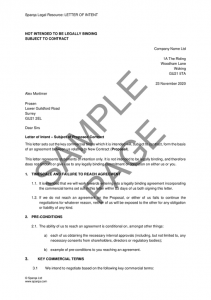 Entering into heads of terms provides you with a non-binding starting point for finalising the legal terms of a formal commercial agreement. We can help you understand the benefits of negotiating and agreeing heads of terms, and you can use our document assembly tool to create your own fully-customised heads of terms in a few clicks.
Entering into heads of terms provides you with a non-binding starting point for finalising the legal terms of a formal commercial agreement. We can help you understand the benefits of negotiating and agreeing heads of terms, and you can use our document assembly tool to create your own fully-customised heads of terms in a few clicks.
Heads of terms: an introduction
Heads of terms are a legal document, often signed in the early stages of a commercial negotiation, to help facilitate business discussions. Heads will usually set out the agreed key commercial points which will form the basis for your ongoing negotiations, and a timescale for entering into a formal commercial agreement. Heads of terms can also be referred to as a memorandum of understanding, heads of agreement, a letter of intent, a term sheet, or simply ‘heads’.
It's another term for 'heads of terms', and it might also be referred to as a letter of intent, term sheet, memorandum of understanding or 'heads'. Heads of agreement are often signed in the early stages of a commercial negotiation, to help facilitate discussions. Heads of agreement will usually set out the key commercial points which form the basis for negotiations between the parties and a timescale for entering into a legally binding agreement.
Heads of terms should be entered into in as a starting point for legal discussions, before the terms of a binding legal agreement are negotiated. The exercise of negotiating and agreeing heads ensures that you have a commercial deal in principle, which you can then translate into a binding legal agreement. Before entering into heads or commencing any other substantive commercial discussions, however, you should ensure you enter into an NDA to protect your business and any confidential information that might form part of such discussions. What are heads of terms?
What is a heads of agreement?
When should I enter into heads of terms?
Use our template NDA to protect your confidential information.
Why should I enter into heads of terms?
Although heads of terms are not normally legally binding, you should consider entering into them if you would like to formalise your discussions with another party, with a view to entering into a binding commercial agreement.
Heads of terms are often regarded by the parties who have signed them as an important ‘commercial agreement in principle’ as they set out the key commercial terms of the negotiations, which the parties will often be reluctant to move away from until they have signed a legally binding agreement.
Without heads of terms, it is easy for negotiations over the detailed legal terms of a commercial agreement to lose focus. The heads provide a helpful reminder to all parties of what was agreed at the outset. If you skip them and dive straight into negotiating a legally binding agreement, it can be easy to lose sight of the original commercial deal and for points that were previously agreed to be re-negotiated.
Going through the process of agreeing heads of terms can also provide a valuable opportunity to see how the other party approaches commercial negotiations. If you are struggling to agree non-binding heads, it gives you an opportunity to step back and re-consider the deal itself, without having incurred the time (and cost) of negotiating a legally binding commercial document.
Do I have to enter into heads of terms?
No, there is no legal requirement for you to enter into heads of terms. However, for any non-routine transaction or arrangement it is highly recommended. Negotiating and agreeing heads will generally facilitate the process of finalising a legally binding commercial agreement.
If you, or your counterparty, are unwilling or unable to agree heads, it may be an indication that negotiations over the legally binding agreement that follows are likely to be protracted and/or unsuccessful.
Entering into heads of terms
What should I include in my heads of terms?
Your head of terms should set out the understanding of the parties as to what the key terms are that they will be negotiating, and how they intend those negotiations to proceed.
In particular, your heads should set out the following:
-
The timescale within which you intend to reach a formal agreement
It will be important for you to consider including a timescale within which your negotiations will take place and after which you expect to have negotiated a full, legally binding commercial agreement.
If you are unable to conclude your negotiations within that set period of time or if either party withdraws from negotiations, you could consider including a provision that, in such circumstances, neither party will have any liability to the other. Although not usually legally binding it will reinforce your intent.
-
Any pre-conditions to your agreement
Pre-conditions are conditions that must be met before either party can enter into a final agreement. For example, you may require certain documents to be signed or regulatory approvals to be granted. Equally, it is likely that you will be carrying out due diligence into the other party to inform you about what the key risks of the transaction might be, and a typical pre-condition might be that you receive satisfactory results to your due diligence exercise.
-
The key commercial terms
Your heads should list the key commercial terms that the parties will be negotiating and which will need to be agreed before you enter into more detailed discussions. These may include provisions about pricing, the duration of the contract, service levels, deadlines, warranties and termination events. You should also set out the key obligations of each party.
-
A declaration that the heads of terms are not intended to be legally binding
You should include a statement in your heads that they are not intended to be legally binding. You could also consider including the words ‘subject to contract’ at the top of the document to make it clear that (if this is the case) none of the terms in the letter have any legal status. Using this phrase will help to create a presumption against a legally binding contract having been created.
Do both parties need to sign heads of terms?
It is best practice for both parties to sign heads of terms to demonstrate their agreement in principle and their commercial commitment to negotiating a formal agreement. A signature represents clear evidence that the heads are agreed.
From a legal perspective, it is important to remember that even if heads of terms are signed, they are not usually be legally binding. For this reason, signing heads (or indeed leaving them unsigned) will not affect your legal obligations or liabilities either way. Heads are simply a statement of intent.
From a commercial perspective, if a party refuses or fails to sign heads of terms, it might be an indication that they are not as committed to the deal as you, or are likely to shift their position when it comes to negotiation of legal documents. You are still free proceed with discussions on such legal documents if your counterparty refuses or fails to sign heads, but should probably do so with caution.
Can my company be liable under heads of terms?
Heads of terms are not generally legally binding unless you specify that they will be. The purpose of heads is to give both parties confidence that a deal is possible and that continuing negotiations is worth the time and expense which you will both incur. Heads are often considered to be ‘morally’ binding, however, as they set out the parties’ intentions to reach a legally binding agreement and provide a focus for their discussions.
In some cases, certain specific clauses of heads of terms can be legally binding. Most commonly these are clauses relating to confidentiality and/or exclusivity periods. You should carefully review the wording of such clauses, to ensure you understand the extent to which any terms are legally binding.
Bear in mind that even if your heads specifically state that they are not legally binding, if English law applies to your negotiations either party may be liable to the other for any loss incurred as a result of false statements or representations made before or during those discussions. Coverage of misrepresentation is outside the scope of this service and if you are concerned about possible liability you should get expert legal advice. For access to a specialist lawyer in a few simple steps, you can use our Ask a Lawyer service.
Can I include legally binding provisions in heads of terms?
Although heads of terms are generally not legally binding, you can include provisions to make certain provisions legally binding (typically these include clauses relating to confidentiality or exclusivity periods).
More detailed coverage of identifying and including legally binding clauses in heads of terms is outside the scope of this service. If you are seeking to include legally binding terms in your heads, or are in any doubt about whether terms you are being asked to sign are legally binding, you can use our Ask a Lawyer service to access a specialist lawyer in a few simple steps.
Next steps
If you want to enter into heads of terms, you can use our document assembly tool to create your own fully-customised heads.
Before doing so, however, you should ensure you have entered into an NDA to protect your business and any confidential information that might form part of your commercial discussions.
After you have signed an NDA, and entered into your heads of terms, you can then proceed with negotiating binding legal terms for your commercial agreement. Our business collaboration agreement can be customised for a range of potential commercial tie-ups, projects or partnerships. For further guidance on the legal process for entering into business collaborations, see our detailed Q&A.
The content in this article is up to date at the date of publishing. The information provided is intended only for information purposes, and is not for the purpose of providing legal advice. Sparqa Legal’s Terms of Use apply.

Harry is General Counsel and Company Secretary of FromCounsel, the specialist corporate legal resource trusted by top global law firms and FTSE 100 companies. Before joining FromCounsel in 2021, Harry was a member of Sparqa’s editorial team for over 4 years, having previously practised as a corporate solicitor for 6 years at Farrer & Co. Harry regularly contributes his expertise to the blog, focusing on corporate and commercial law.






